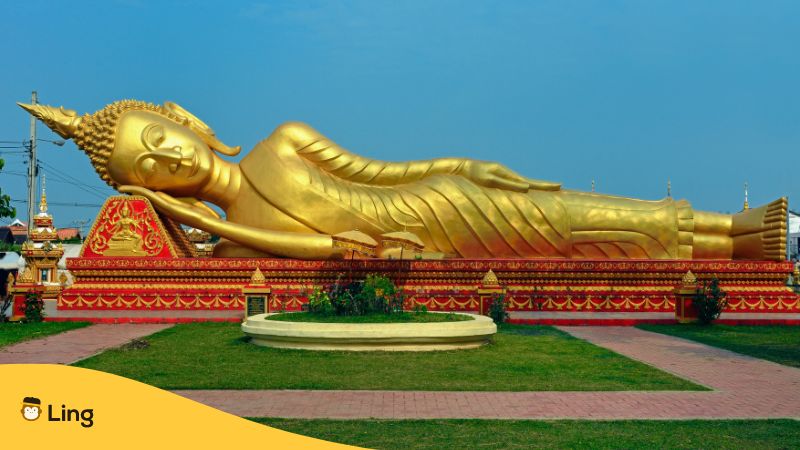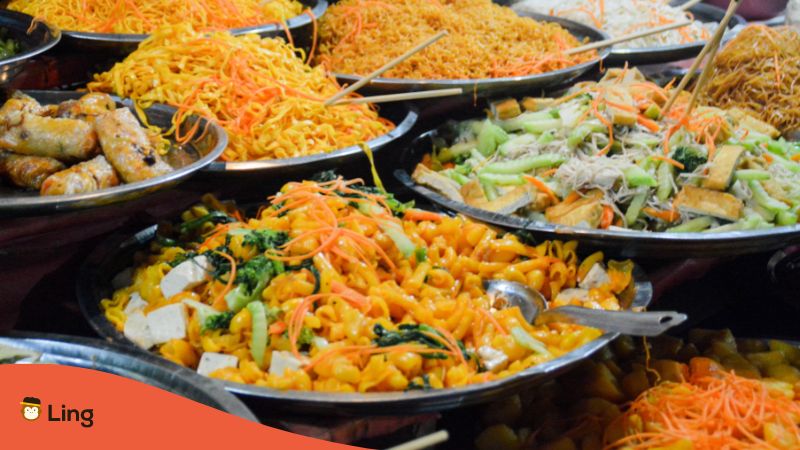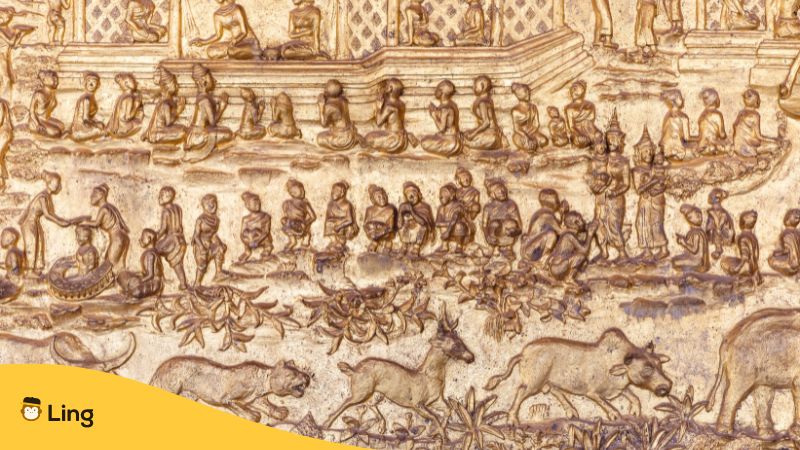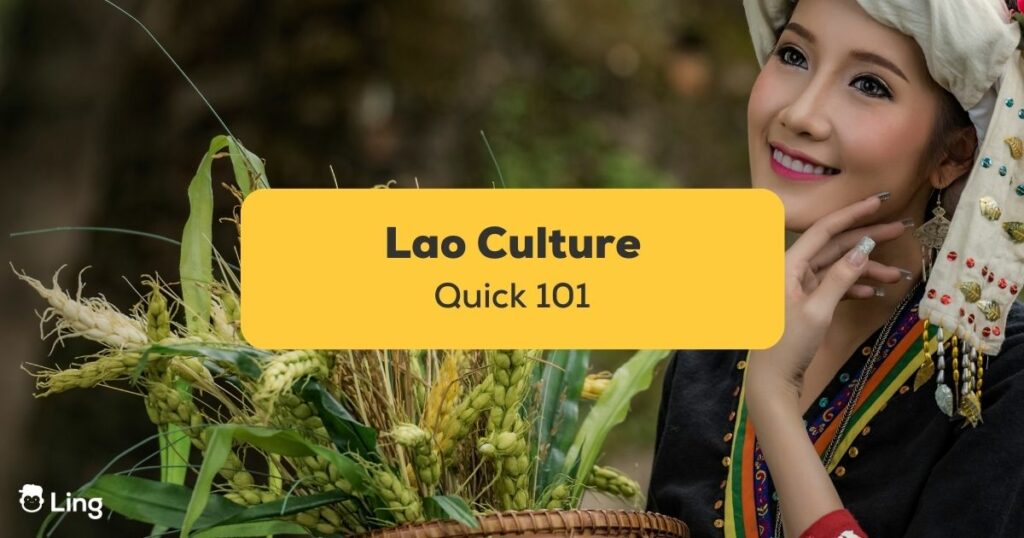Hey there, did you know that in Lao culture, it is considered bad luck to whistle at night? So if you’re planning on walking through the streets of Laos after sunset, maybe save your musical talents for a daytime karaoke session!
But there’s so much more to this incredible culture than just whistling taboos. From their delicious cuisine to their colorful traditional clothing, Laotians hailing from diverse ethnic groups have a rich cultural heritage that is often overlooked.
In this article, we’ll take a deep dive into the fascinating world of Laotian culture (vadthanathoa – ວັດທະນະທໍາ) – a culture that considers the Mekong River as its national identity, so much so that they put it up in their national flag! We’ll explore their customs and traditions, from their love of sticky rice to their intricate dance performances. So sit back, grab a Beerlao, and get ready to discover the unique and vibrant world of Laos’ culture.

Significance Of The Lao Culture
Culture plays a vital role in shaping Laotian society, as it provides a sense of identity and belonging to the Lao people. From their traditional clothing to their cuisine and music, culture influences the way people in Laos think, behave, and interact with each other. Theravada Buddhism (phudthasasanikason – ພຸດທະສາສະນິກະຊົນ), the dominant religion in Laos, also heavily influences the culture, with beliefs and traditions such as the Baci ceremony (phithi ba si – ພິທີບາຊິ) and spirit worship shaping everyday life.
Additionally, culture plays a significant role in promoting social cohesion in Laos, creating a shared sense of history and collective memory that binds the Lao people together. Thus, culture is essential in shaping Laotian society, influencing everything from art and literature to political and economic systems.
Various Facets Of The Laotian Culture
#1 Ethnicity (Sonpheoa – ຊົນເຜົ່າ)
The Laotian culture is an amalgamation of various ethnic groups that have lived in the region for centuries. In the context of ethnic diversity, according to the official estimate, there are 50 ethnic groups in Laos. The majority of the population is Lao Loum – the largest ethnic group – who make up about 68% of the Lao population. The term literally means ‘lowland Lao.’ The remaining 32% is divided between the ethnic groups Lao Theung and Lao Soung, who are hill tribes living in the northern and southern parts of Laos, respectively.

#2 Religion (Sadsana – ສາດສະໜາ)
Religion plays a significant role in the small country of Lao People’s Democratic Republic, where the majority of the population practices Theravada Buddhism. This religion heavily influences their beliefs and traditions, including the Baci ceremony, where people tie strings around each other’s wrists as a symbol of goodwill and blessings. The belief in spirits and ghosts is also widespread in this land’s culture.
#3 Language (Phasa – ພາສາ)
The official language of Laos is Lao, which is also the most widely spoken language in the country. It is a tonal language with six tones and is written in the Lao script, which is closely related to the Thai script. Lao is a member of the Tai-Kadai language family and is spoken by over 80% of the population in Laos.
In addition to Lao, there are several other minority languages spoken in Laos, including the native language of Hmong, Khmu, and Tai Dam. These languages are primarily spoken by ethnic minority groups in the northern and southern regions of the country. French and English are also spoken as second languages by some Laotians, particularly those in urban areas. The language diversity in Laos reflects the country’s rich cultural heritage and diverse ethnic group makeup.
#4 Beliefs & Traditions (Khuaamseu & Papheni – ຄວາມເຊື່ອ & ປະເພນີ)
Lao beliefs and traditions are heavily influenced by Theravada Buddhism. Buddhism plays a significant role in shaping daily life in Laos, with beliefs and traditions such as the Baci ceremony and spirit worship being an integral part of the culture.
The Baci ceremony is a traditional Lao ritual that involves tying strings around a person’s wrist to bring good luck and ward off evil spirits. This ceremony is often performed by the local community during important life events, such as weddings, births, and funerals.
Another important tradition in Laos is the Rocket Festival (Boun Bang Fai – ບຸນບັ້ງໄຟ), which is held annually in May to celebrate the coming of the rainy season. The festival involves launching homemade rockets into the sky to ask for rain and good harvests.
Laotian culture also places a strong emphasis on respect for elders and hospitality towards guests, with the concept of ‘greng jai’ (being considerate and respectful) being an important part of social interactions. In retrospect, Lao beliefs and traditions reflect the country’s strong Buddhist heritage and emphasize the importance of community, respect, and hospitality.

#5 Food (Ahaan – ອາຫານ)
Lao cuisine is a delicious and diverse blend of flavors and textures, heavily influenced by neighboring Thailand and Vietnam. Sticky rice is a staple food in Lao cuisine, and it is often served with a variety of side dishes, including grilled meats, spicy dips, and soups. Lao dishes often feature fresh herbs, vegetables, and chili peppers, giving them a spicy, tangy flavor.
Some of the most popular Lao dishes include larb – a spicy minced meat salad, and tam mak hoong – a spicy papaya salad made with fish sauce, lime, and chili peppers. Other popular dishes include laap – a spicy meat salad, and mok pa – a steamed fish dish wrapped in banana leaves.
Lao cooking also includes a range of snacks and street foods, such as khao jee – a baguette sandwich filled with meat, vegetables, and chili sauce, and sai oua – a spicy Lao sausage made with lemongrass, kaffir lime leaves, and chili peppers. And like many cultures across the world, most Lao people love to end their meals with the choicest of Lao desserts.
So, would it really be an exaggeration to say that Lao cuisine is a unique and flavorful culinary experience, blending the best of Southeast Asian flavors and traditions?

#6 Clothing (Kheuongnung Hom – ເຄື່ອງນຸ່ງຫົ່ມ)
Traditional Lao clothing includes the pha sin – a sarong-like skirt worn by women, and the pha biang – a silk sash worn by both Lao women and men. These clothes are often brightly colored and intricately embroidered.
#7 Music & Dance (Donti & Kan Ten – ດົນຕີ & ການເຕັ້ນ)
Lao music and dance are closely tied to their religious and cultural traditions. The classical music of Laos, known as lam, is played on traditional instruments such as the khaen – a bamboo mouth organ, and the pin – a three-stringed lute. Dance performances often tell stories from Lao folklore and are accompanied by live music.

#8 Art & Literature (Sinlapa & Vannakhadi – ສິນລະປະ & ວັນນະຄະດີ)
Art and literature have a long history in the Laotian culture, with the earliest known Lao literature dating back to the 14th century. Traditional Lao art includes intricate wood carvings, murals, and woven textiles. Generally speaking, modern Lao literature often focuses on social issues, and the country has produced several notable writers in recent years.
#9 Architecture (Satha Pad Ta Nya Koa – ສະຖາປັດຕະຍະກໍາ)
Lao architecture is a unique blend of traditional and contemporary styles, heavily influenced by Buddhist beliefs and practices. One of the most prominent examples of Lao architecture is the famous Pha That Luang, a gold-covered stupa located in Vientiane, the capital city of Laos. This iconic monument is considered a national symbol of Laos and represents the country’s strong Buddhist heritage.
Another important Buddhist temple is Wat Xieng Thong, located in the ancient city of Luang Prabang. This temple is renowned for its intricate wood carvings and exquisite mosaic artwork, which showcase the fine craftsmanship and attention to detail in Lao architecture.
Other notable monuments and temples in Laos include the Buddha Park, a collection of more than 200 religious statues located near Vientiane, and the Pak Ou Caves, which house thousands of Buddha images and statues.
Lao architecture is also influenced by French colonial architecture, which is characterized by intricate wood carvings, colorful decorations, and ornate designs. These reflect the country’s rich cultural heritage and strong Buddhist influences too.

Intrigued By Laotian Culture? Learn Basic Lao With Ling!
This was a small peek into the Laotian culture. If that’s got you wanting for more, head straight to the blog section of the Ling app. You will be amazed to find an array of well-curated articles on topics like culture, history, tradition, food, and people, designed and written exclusively for the purpose of language learning. Now, isn’t that an amazing way to learn Lao?
For further practice, you can download the Ling app on your phone too! The app features a gamified interface designed to help you retain new vocabulary much more easily, with the help of fun interactive exercises and simple quizzes.
Want to know more? On the Ling app, you can learn 60+ other Southeast Asian and European languages! You can begin your learning journey with the first two lessons in the app for free! So, what are you waiting for? Go to the Google Play Store or Apple App Store, and download the Ling app for free now!

































































